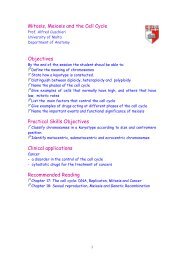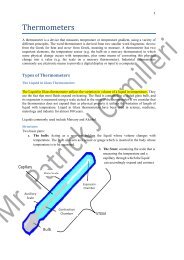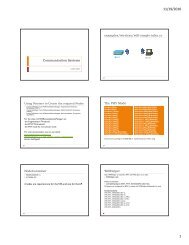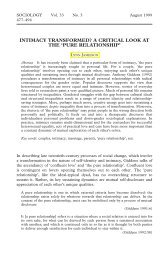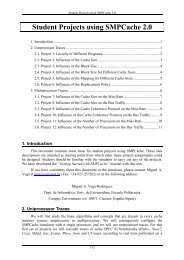Development of liver and pancreas - University of Malta
Development of liver and pancreas - University of Malta
Development of liver and pancreas - University of Malta
Create successful ePaper yourself
Turn your PDF publications into a flip-book with our unique Google optimized e-Paper software.
<strong>Development</strong> <strong>of</strong> the Liver <strong>and</strong> Pancreas<br />
Pr<strong>of</strong>essor Alfred Cuschieri<br />
Department <strong>of</strong> Anatomy<br />
<strong>University</strong> <strong>of</strong> <strong>Malta</strong>
Three gl<strong>and</strong>ular buds arise from the distal end<br />
<strong>of</strong> the foregut during the fourth week<br />
Day 22 -The hepatic bud<br />
projects into the ventral<br />
mesogastrium <strong>and</strong> grows in<br />
the septum transversum.<br />
Day 28 –The<br />
ventral pancreatic bud<br />
grows into the ventral mesogastrium<br />
Day 26 –The<br />
dorsal pancreatic bud<br />
grows into the dorsal<br />
mesogastrium
Two pancreatic buds develop from the distal end<br />
<strong>of</strong> the foregut endoderm during the fourth week<br />
Day 28 –<br />
The ventral pancreatic bud<br />
grows into the ventral mesentery<br />
just distal to the bile duct<br />
Day 26 –<br />
The dorsal pancreatic bud<br />
grows into the dorsal<br />
mesentery
The Position <strong>of</strong> the Pancreatic Buds Is Altered<br />
by Two Rotations<br />
1. The ventral <strong>pancreas</strong> migrates to the dorsal<br />
aspect <strong>of</strong> the foregut.<br />
The superior mesentric artey is trapped between<br />
the two pancreatic rudiments
2. The foregut <strong>and</strong> dorsal mesentery fold to the right<br />
As a result:<br />
• The dorsal mesentery is obliterated<br />
• The <strong>pancreas</strong> becomes retroperitoneal
The dual origin <strong>of</strong> the <strong>pancreas</strong> explains the<br />
anatomical relations <strong>of</strong> the <strong>pancreas</strong><br />
The two pancreatic buds fuse in the 6 th<br />
week to form the definitive <strong>pancreas</strong><br />
The dorsal <strong>pancreas</strong> forms<br />
the head, body <strong>and</strong> tail<br />
The ventral <strong>pancreas</strong> forms<br />
the uncinate process<br />
The superior mesenteric artery emerges dorsal to<br />
the body <strong>and</strong> ventral to the uncinate process
The two pancreatic ducts are re-arranged to<br />
form a common opening into the duodenum.<br />
The main (dorsal) duct<br />
anastomosis with the<br />
ventral duct.<br />
The main duct loses its<br />
connection with the<br />
duodenum.<br />
The opening <strong>of</strong> the<br />
ventral duct becomes<br />
the main opening.<br />
The pancreatic duct <strong>and</strong> bile<br />
duct open into a common<br />
ampulla <strong>of</strong> Vater.<br />
Sphincter <strong>of</strong> Oddi develops from<br />
mesenchyme at 12 weeks
An Accessory Pancreatic Duct (<strong>of</strong> Santorini) Is Often<br />
Present in Normal Individuals.<br />
It is due to anomalous anostomoses between the ventral<br />
pancreatic duct <strong>and</strong> the opening <strong>of</strong> the dorsal duct.<br />
When present, the accessory pancreatic duct:<br />
•receives the ducts from the uncinate process,<br />
•opens into the duodenum proximal to the major papilla<br />
•<strong>of</strong>ten communicates with the main duct.
The acini <strong>and</strong> islets <strong>of</strong> Langerhans both<br />
differentiate from the foregut endoderm.<br />
They arise from<br />
distinct cell clusters.<br />
Islet cells<br />
Acinar cells<br />
The pancreatic acini begin to form zymogen<br />
granules from the 8 th week. They secrete<br />
digestive enzymes at 30 weeks (7 months).<br />
The islets <strong>of</strong> Langerhans differentiate into distinct cell<br />
types during the 8 th -9 th weeks in the following order:<br />
α-cells: glucagon<br />
β-cells: insulin<br />
δ-cells: somatostatin<br />
PP-cells: pancreatic polypeptide<br />
Specific granules are evident by the 9 th week.<br />
Islets secrete insulin at 21 weeks (5 months).
<strong>Development</strong> <strong>and</strong> Differentiation <strong>of</strong> the<br />
Pancreas<br />
The dorsal <strong>pancreas</strong> is induced by the notochord.<br />
The ventral <strong>pancreas</strong> is induced by hepatic mesoderm<br />
Differentiation <strong>of</strong> the acini depends on the presence<br />
<strong>of</strong> mesoderm, but this need not be pancreatic<br />
mesoderm.<br />
Differentiation <strong>of</strong> the islets <strong>of</strong> Langerhans does not<br />
require the presence <strong>of</strong> mesoderm or <strong>of</strong> pancreatic<br />
acini.<br />
It was originally thought that the Islets were derived from the<br />
neural crest. Evidence from quail-chick chimera cell tracers <strong>and</strong><br />
transgenic animals indicates that islet cells are derived from forgut<br />
endoderm.
Anomalies <strong>of</strong> the Pancreas<br />
1. Annular <strong>pancreas</strong>:<br />
• thought to arise from the ventral <strong>pancreas</strong><br />
migrating on both sides <strong>of</strong> the dodenum<br />
• It may cause duodenal obstruction<br />
• It is <strong>of</strong>ten associated with duodenal atresia<br />
2. Ectopic pancreatic tissue:<br />
• may occur in the duodenum, stomach or Meckel’s<br />
diverticulum or rarely in the appendix, biliary tract,<br />
ileum or lungs<br />
• causes vague abdominal pain due to the ectopic<br />
secretion <strong>of</strong> proteolytic enzymes<br />
• may simulate peptic ulcer or appendicitis<br />
• difficult to diagnose clinically
The <strong>liver</strong> <strong>and</strong> biliary system develop from the<br />
hepatic diverticulum<br />
• The distal end proliferates<br />
rapidly in the septum transversum<br />
to form the hepatocytes <strong>and</strong><br />
intra-hepatic biliary system<br />
•The proximal part in the<br />
ventral mesogastrium<br />
proliferate slowly, becomes<br />
relatively narrow <strong>and</strong> forms<br />
the extrahepatic biliary<br />
system.<br />
• A secondary outgrowth<br />
from it forms the gall bladder<br />
<strong>and</strong> cystic duct during the 4 th<br />
week (day 24)
Rudiments <strong>of</strong> the Liver <strong>and</strong> Biliary system<br />
Hepatic<br />
diverticulum<br />
Vitelline <strong>and</strong><br />
umbilical veins<br />
Septum<br />
transversum<br />
mesoderm<br />
Liver cords<br />
&<br />
Biliary duct<br />
epithelium<br />
Sinusoids<br />
&<br />
portal vein<br />
Space <strong>of</strong> Disse<br />
Kupffer cells<br />
Haemopoietic tissue<br />
Hepatic artery<br />
Connective tissue
Rudiments <strong>of</strong> the Liver <strong>and</strong> Biliary system<br />
Hepatic<br />
diverticulum<br />
Vitelline <strong>and</strong><br />
umbilical veins<br />
Septum<br />
transversum<br />
mesoderm<br />
Liver cords<br />
&<br />
Biliary duct<br />
epithelium<br />
Sinusoids<br />
&<br />
portal vein<br />
Space <strong>of</strong> Disse<br />
Kupffer cells<br />
Haemopoietic tissue<br />
Hepatic artery<br />
Connective tissue
Septum<br />
transversum<br />
mesoderm<br />
C-met<br />
receptor<br />
Hepatic<br />
diverticulum<br />
The septum transversum mesoderm<br />
has an inductive influence on<br />
hepatic bud endoderm.<br />
Hepatic<br />
growth<br />
factor<br />
It releases hepatic<br />
growth factor that<br />
interacts with receptors<br />
on the <strong>liver</strong> cells.<br />
Liver cords
<strong>Development</strong> <strong>of</strong> Liver Function<br />
• Synthesis <strong>of</strong> serum albumin –5 th week<br />
• Secretion <strong>of</strong> bile –12 th week<br />
-From the 4 th month till birth the intestinal<br />
contents are dark green <strong>and</strong> termed meconium.<br />
• Glycogen storage – late foetal life<br />
• Haemopoiesis is a major function <strong>of</strong> the <strong>liver</strong><br />
from the 4 th week to birth<br />
-Haemopoieticcells:<br />
• are derived from septum transversum mesoderm<br />
• are situated in clusters in spaces between hepatic<br />
cells.
Changes in the veins coursing through the<br />
septum transversum account for some<br />
anatomical features <strong>of</strong> the <strong>liver</strong><br />
Initially veins are symmetrical
Paired umbilical <strong>and</strong> vitelline veins course through the<br />
septum transversum <strong>and</strong> drain into the sinus venosus<br />
Right<br />
Umbilical veins<br />
Vitelline veins<br />
Left<br />
Sinus venosus<br />
Diaphragm<br />
Septum<br />
transversum<br />
A series <strong>of</strong> anastomoses connect the right <strong>and</strong> left<br />
vitelline veins. Two anastomoses lie ventral <strong>and</strong> one<br />
dorsal to the terminal part <strong>of</strong> the foregut. The most<br />
cranial anastomosis lies within the septum transversum.
Proliferation <strong>of</strong> cells <strong>of</strong> the hepatic diverticulum<br />
disrupts the symmetrical pattern <strong>of</strong> the veins<br />
coursing through the septum transversum<br />
The hepatic veins<br />
drain the <strong>liver</strong><br />
sinusoids into the<br />
right vitelline veins.<br />
The vitelline veins break<br />
up into a plexus that<br />
surrounds the rapidly<br />
growing cords <strong>of</strong> hepatic<br />
cells <strong>and</strong> forms the <strong>liver</strong><br />
sinusoids
5.<br />
4.<br />
2.<br />
As the left horn <strong>of</strong> the sinus venosus regresses, all the<br />
veins are shunted to the right vitelline vein.<br />
1. The left vitelline <strong>and</strong> umbilical<br />
veins lose their connections with<br />
the left horn <strong>of</strong> the sinus venosus<br />
2. The right umbilical vein disappears<br />
completely<br />
3. The ductus venosus shunts blood<br />
from the left umbilical to the cranial<br />
end <strong>of</strong> the right vitelline vein.<br />
4. The <strong>liver</strong> sinusoids drain into the<br />
right vitelline veins through the<br />
hepatic veins<br />
5. The cranial part <strong>of</strong> the right vitelline vein<br />
enlarges <strong>and</strong> forms part <strong>of</strong> the <strong>of</strong> the IVC
The Umbilical Veins<br />
1. The right umbilical vein disappears<br />
completely<br />
2. The left umbilical veins lose its<br />
connection with the left horn <strong>of</strong> the<br />
sinus venosus<br />
3. The ductus venosus shunts blood<br />
from the left umbilical to the cranial<br />
end <strong>of</strong> the right vitelline vein.<br />
Remember! The umbilical cord has only one vein<br />
(the left umbilical vein)
Re-arrangement <strong>of</strong> the paired vitelline veins<br />
gives rise to the portal vein<br />
In the septum transversum - Parts<br />
<strong>of</strong> the right <strong>and</strong> left vitelline veins<br />
<strong>and</strong> the ventral anastomosis give<br />
rise to the right <strong>and</strong> left branches<br />
<strong>of</strong> the portal vein<br />
Outside the septum transversum -<br />
The portal vein develops from<br />
parts <strong>of</strong> the right <strong>and</strong> left vitelline<br />
veins <strong>and</strong> the dorsal anastomosis.<br />
The splenic <strong>and</strong> superior mesenteric<br />
veins develop join the left vitelline<br />
vein; later, the inferior mesenteric<br />
vein joins the splenic vein.
The portal vein develops partly from the dorsal<br />
anastomosis. This explains why it passes<br />
dorsal to the first part <strong>of</strong> the duodenum.<br />
Portal vein<br />
Superior<br />
mesenteric vein<br />
Splenic vein<br />
Inferior<br />
mesenteric vein
The development <strong>of</strong> the veins explain some <strong>of</strong><br />
the anatomical features <strong>of</strong> the <strong>liver</strong>.<br />
Inferior vena cava<br />
(right vitelline v.)<br />
Hepatic veins<br />
drain into IVC<br />
Portal vein<br />
Ductus venosus<br />
Umbilical vein<br />
(left)
Embryological veins <strong>and</strong> their derivatives in the<br />
mature <strong>liver</strong>.<br />
A mirror image <strong>of</strong> the previous diagram illustrates the <strong>liver</strong><br />
as seen from the posterior aspect, in order to facilitate<br />
comparison with the derivatives in the mature <strong>liver</strong>.<br />
L R<br />
L<br />
R<br />
Right vitelline V<br />
Inferior Vena Cava<br />
Ductus venosus<br />
Fissure for<br />
ligamentum venosum<br />
Umbilical vein<br />
Fissure for ligamentum teres
Anomalies <strong>of</strong> the Liver <strong>and</strong> Biliary System<br />
1. Duplication <strong>of</strong> the gall bladder, sharing the same<br />
common bile duct<br />
2. Extrahepatic biliary atresia<br />
• variable absence <strong>of</strong> part or all <strong>of</strong> the biliary tree<br />
• causes severe jaundice shortly after birth<br />
• requires surgery to relieve the obstruction (e.g.<br />
cholecysto-gastrostomy)<br />
• prognosis depends on site <strong>and</strong> extent <strong>of</strong> the<br />
atresia; more severe if proximal part is involved<br />
3. Biliary hypoplasia due to intrahepatic biliary<br />
atresia
The stomach develops in the septum transversum<br />
<strong>and</strong> has dorsal <strong>and</strong> ventral mesenteries<br />
Lateral structures<br />
Paraxial mesoderm<br />
Intermediate<br />
cell mass<br />
Pleuro-peritoneal<br />
canal<br />
28 day embryo:<br />
TS at the level <strong>of</strong><br />
septum transversum<br />
The spleen develops in the dorsal<br />
mesentery.<br />
The <strong>liver</strong> develops in the ventral<br />
mesentery.<br />
Midline structures<br />
Neural tube<br />
Notochord<br />
Dorsal aorta<br />
Dorsal mesentery<br />
Developing Stomach<br />
Ventral mesentery
The <strong>liver</strong> <strong>and</strong> biliary system develop from the<br />
hepatic diverticulum<br />
• The distal end <strong>of</strong> the hepatic divertivculum<br />
proliferates rapidly in the septum transversum to form<br />
the hepatocytes <strong>and</strong> intra-hepatic biliary system<br />
• The proximal part in the ventral mesogastrium does not<br />
proliferate rapidly, becomes relatively narrow <strong>and</strong><br />
forms the extrahepatic biliary system. A secondary<br />
outgrowth from it forms the gall bladder <strong>and</strong> cystic<br />
duct during the 4 th week (day 24)<br />
• The vitelline <strong>and</strong> umbilical veins, disrupted by growth<br />
<strong>of</strong> hepatic cells in the septum transversum, form the<br />
<strong>liver</strong> sinusoids<br />
• The septum transversum mesoderm surrounding the<br />
hepatic cords forms the Kuppfer cells <strong>and</strong><br />
haemopoietic cells




